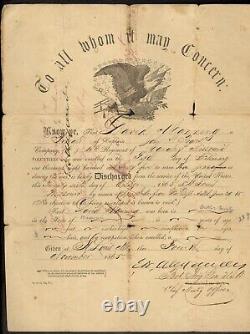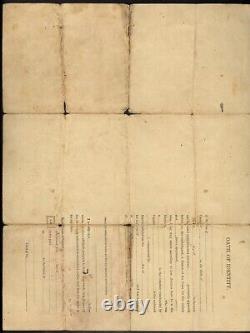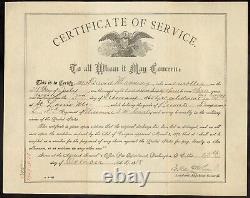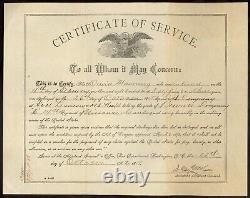
- Index
- Brand
- Composition
- Era
- Genre
- Isbn
- Type
- Action Figure (28)
- Artillery (2)
- Biography (3)
- Bust (2)
- Cavalry (3)
- Civil War Map (3)
- Code Key (4)
- Figure (2)
- History (2)
- Negative Film Photo (9)
- Painting (5)
- Photograph (491)
- Photograph Album (5)
- Print (18)
- Santa (6)
- Sculpture (25)
- Sports Trading Card (2)
- Statue (3)
- Steam Locomotive (6)
- Textbook (2)
- ... (3513)
1865 Eagle Discharge Signed Twice by Brigadier General Edmund B. Alexander








1865 Eagle Discharge Signed Twice by Brigadier General Edmund B. Offered for your consideration are three documents relating to the discharge of a private from a Missouri cavalry regiment, one signed at the conclusion by a long-serving United States officer. The principal document is a standard Union military discharge, highlighted by a spread-winged bald eagle, a bundle of arrows and an olive branch in its talons, standing atop an American shield, with flags and stars in the background.
Immediately above, presented in a arc, is printed " To all whom it may Concern: ", while below it instructs the reader to Know ye, That David Manning a Private of Captain John P. Roger's Company, (C), 14.
Regiment of Cavalry Missouri Volunteers who was enrolled on the Fifth day of February one thousand eight hundred and Sixty five to serve Three years. Or during the war, is hereby Discharged from the service of the United States, this Twenty sixth day of October, 186 5, at St.
Louis Missouri by reason of Spec. (No objection to his being re-enlisted is known to exist).
The following paragraph provides a physical description of Private Manning, though the spaces were originally completed with curled lines (his place of birth and age have been written above in another hand). This document was Given at St Louis Mo this Fourth day of November 186 5. " and it is boldly signed at the conclusion by " E. Alexander " in his capacity as " Bvt." and " Chief Must'g Officer. A manuscript, red ink notation, somewhat difficult to read, appears vertically to the left of center. It seems to indicate that Private Manning was sick at the time his company was discharged and that he was paid on Nov. A second signature of General Alexander is also present, again accomplished in dark ink.
A partly-printed " OATH OF IDENTITY " (unaccomplished) dominates 1/3 of the back of the document, while the remaining 2/3 is blank. This document is offered with two additional, related items.
Both are headlined " CERTIFICATE OF SERVICE " and bear a spread-winged eagle as the central vignette. The first of these states: To all Whom it May Concern: This is to Certify, That David Manning, who was enrolled on the 27. Day of July, one thousand eight hundred and Sixty three, to serve three years, was discharged to date the 3.
Day of February, 186 5, by re-enlistment in 14. Mo Cavlry at St Louis Mo. While holding the grade of Private in Company' L', 3.
Cavlry, and serving honorably in the military of the United States. It was Given at the Adjutant General's Office, War Department, Washington, D. 18 88 " and is signed at the conclusion by the " Assistant Adjutant General. The second document is another " CERTIFICATE OF SERVICE ", this one for Manning's discharge on. Day of October, 18 65. , bearing the same date and signature as the previous. It is interesting to find this second document, as it was supposed to replace the Eagle Discharge that is included with this lot, though it obviously still exists.These documents would look great framed together, or the discharge could be framed with a period portrait of General Alexander in uniform. Nice grouping from this politically divided state. Was born in Haymarket, Virginia, on October 6, 1802.
He attended the United States Military Academy at West Point, New York, from 1818 through 1823, and upon graduation, was appointed brevet second lieutenant in the 6. He was subsequently advanced to second lieutenant in the 3. US Infantry, with the same date of rank. He served at military posts in Iowa, Michigan, Wisconsin, Missouri, Illinois, and Louisiana from 1824 through 1831.
For the next nine years, Alexander served alternately between Fort Towson, Indian Territory and Fort Jesup, Louisiana, with a year spent at Fort Smith, Arkansas in 1839. During the Mexican-American War, Alexander participated in the siege of Vera Cruz, the battles of Cerro Gordo, Contreras, and Churubusco, and the storming of Chapultepec, leading to the assault and capture of Mexico City. He was brevetted major for Cerro Gordo and lieutenant colonel for Contreras and Churubusco. During this period, he was promoted to major of the 8. US Infantry, and in March, 1855, he was advanced to colonel and appointed as commander of the newly formed 10. He subsequently served on garrison duty in Pennsylvania and Minnesota until his participation in the Utah Expedition of 1857-58. From 1858-60 he took a leave of absence, after which he served for two years at Fort Laramie in the Dakota Territory and a short time at Fort Kearney, Nebraska. Between May 1, 1863 and April 25, 1866, Alexander served as Acting Assistant Provost Marshal General, Superintendent of Volunteer Recruiting Service, and Chief Mustering and Disbursing Officer for the state of Missouri, after which he served as commander of the 10. US Infantry at Fort Snelling, Minnesota until his retirement from active service on February 22, 1869. Alexander died on January 3, 1888 in Washington, D. And was buried in Oakland Cemetery in St. Each of the presently offered documents exhibits a different amount of wear, with the eagle discharge being the most heavily damaged of the lot. This piece displays significant toning across the entire surface, with heavier concentrations at the edges, along the folds, and on the back (this would have been the outside when the document was folded). In addition to the toning, significant soiling and staining can be seen throughout. Numerous folds are present, several of which have affected the integrity of the paper causing separations and loss of paper at the junctures and edges (these could be strengthened with archival tape if desired). Though originally straight, the edges are now slightly ragged, with paper loss noted at the junctures with the folds. Fading is noted on the red additions causing them to be difficult to read, though the body of the document is fully legible. The signatures are sharp and bold, though both have been bisected by folds.The other two certificates each exhibit moderate toning, neatly divided by the vertical folds in the paper (see illustrations). These folds have slightly affected the integrity of the pieces, though no separations or paper loss is noted at this time. Minor fading can be seen, though this may be partially due to the amount and type of ink employed. The eagle discharge measures approximately 8?
X 11 inches, while the other two measure approximately 8 x 10? Any additional questions regarding condition should be addressed before purchasing. If you have any questions regarding this item, please ask before purchasing. He has contributed to numerous reference books within the industry, as well as being a co-author of The Comprehensive Catalog and History of Confederate Bonds, 2.
He is an authorized submitter to NGC, PCGS, and PMG, a diamond founding member of Coin Dealers Helping Coin Dealers and a supporter of the Industry Council for Tangible Assets. American Coins and Collectibles can be found at many of the state and local coin shows. This item is in the category "Collectibles\Militaria\Civil War (1861-65)\Original Period Items\Documents".
The seller is "coin4u" and is located in this country: US. This item can be shipped to United States.- Modified Item: No
- Country/Region of Manufacture: United States
- Theme: Militaria
- Original/Reproduction: Original
- Conflict: Civil War (1861-65)

